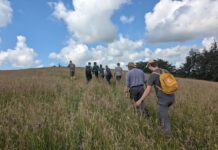
A plot of land next to one of the busiest roads in Essex has become a home for a variety of endangered wild birds, in work undertaken by National Highways.
The project, which began in 2018, on a site adjacent to the A120 near Braintree, has been developed into a natural habitat for wild birds.
Lucy Robison-Smith – an Environmental specialist with National Highways – and Rob Murray – a volunteer for the British Trust for Ornithology (BTO) – were responsible for establishing the site and developing it over the last four years.
National Highways, which owns the land as part of its wider estate, has also been using the area to support the BTO and their ‘egg-cellent’ work to monitor local bird populations.
BTO, along with a number of other organisations, contribute data to the Birds of Conservation Concern report. This periodic review of bird populations across the UK is used to identify and support conservation around those species considered most at risk.
Since the scheme began in November 2018, 259 birds have been caught and ringed by local BTO volunteer Rob Murray, with the support of National Highways’ Environment Team
Endangered species which have been seen in the area include Song Thrush, Dunnock and Bullfinch; all of which appear on the amber list of the latest publication of the UK Birds of Conservation Concern. This means their populations in the UK have dropped between 25% – 50% over the last 25 or 50 years.
Other bird species spotted on the land include long-tailed tit, robin, treecreeper, goldfinch and the great spotted woodpecker.
To date, over 50 of the birds that have previously been ringed at the site have been subsequently recorded meaning they are regular visitors or a bit of a ‘home bird’.
Special nets are used to catch the birds, so they can be ringed and recorded before being released. The nets do not harm the birds and look like a very light and thin volleyball net.
The ‘owl-some’ drive to encourage wildlife alongside the strategic road network has led to a £6 million investment from National Highways to create the Network for Nature Programme.
This joint project, with The Wildlife Trusts, will fund projects that help to create, restore and connect places for wildflowers, trees and wildlife, where the environment has been previously impacted by road building.
Overall, twenty-six biodiversity projects will enhance, restore and create more than 1,700 acres (690 hectares) of woodlands, grasslands, peatlands and wetlands across every region of England.
Helping to further develop the area off the A120, which includes woodland and a large pond, six tit nest boxes have been installed. With three of the boxes occupied by Blue Tits, 21 new ‘chicks off the block’ were successfully fledged earlier this year and ringed for future monitoring.
Around the pond – known as a balancing pond because it’s where excess water from the carriageway is drained after heavy rainfall – a number of reed warblers have been caught and ringed with several nests also being located. These birds are summer visitors to the UK and winter in sub-Saharan Africa.
Simon Baldrey, National Highways East Region Environment Manager, said:
“This is a brilliant example of the work we are doing across the country to create homes for wildlife and encourage the natural environment to flourish near our roads.
“Across England, the roadside estate is vast and sits alongside some of our most precious habitats. Working with organisations like the British Trust for Ornithology, and passionate individuals like Rob, helps us to create crucial natural corridors for birds and many other types of wildlife.”
Lee Barber, Demographic Surveys Officer, from BTO added:
“It is fantastic to hear about the wonderful birds recorded at this site, which shows the importance of such habitats for the UK’s bird populations. Thanks to the work of citizen scientists like Rob, BTO is able to gather data that reveal the long-term impacts of habitat loss and climate change. This means conservation efforts can be targeted more effectively and our birdlife protected for the future.”







